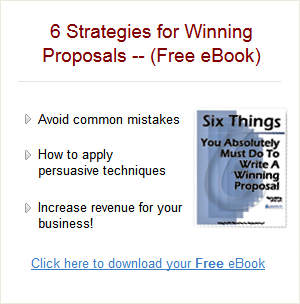Right On Target: How to Create a Winning Proposal
Proposal writing is one of the most crucial skills in selling to government. But how do you win in these competitive situations? More proposals are rejected than accepted. Invariably, price is blamed as the villain, but in fact, price is rarely the only consideration and many times not even the main one. Proposing the lowest cost solution will not guarantee success unless you have also convinced the evaluators that you can do the job.
Even if you have the best products, you might lose if the customer is concerned about your service capabilities, or your ability to meet the deadlines, or the risks of doing business with you. Winning proposals, regardless of the product, service or organization, have a number of characteristics in common. They all prove what they are saying, demonstrating the wisdom of selecting the supplier. They provide practical examples. They provide clear evidence of the bidder’s superior capabilities. They do not include grandiose, sweeping claims such as “we have the best widgets in the industry.” It is much more effective to provide the evalua-tors with the evidence. For example, “Our widgets have become a standard in your industry and are being used successfully by 10 of the major cities in this state. Their names and telephone numbers are in the reference section.” For your proposal to be taken seriously, you need to convince each of the evaluators of four basic facts.
Convince Evaluators That You Understand the Problem
Often firms fail because they do not make the evaluators aware of their experience, that they have dealt with this problem many times before. Instead of demonstrating their specific experience in relevant areas, they simply paraphrase the customer’s definition of the problem. For example, one supplier responding to the RFP from a college stated that it had worked with other similar institutions. Its competition went much further; it described some of the problems that another institution had experienced during the implementation and how it had helped the customer overcome these difficulties. By doing this, its proposal was identified by the evaluators as the least-risk solution. To prove that you can do the job better than your competition, you need to show that you understand the problem or situation, and in particular, that you understand the buyer’s concerns (which may not have been stated in the RFP).
Convince Evaluators That You Can Solve the Problem
The next challenge is to demonstrate that you can actu-ally solve the problem and have a plan that will produce the required results. Your proposed solution must be practical; the customer must be able to see where it goes. The proposed solution should not be vague and should address all of the purchaser’s concerns. Based on your firm’s specific experience, you should demonstrate that the plan will work, that each element of the plan is feasible and entails little risk. Make your plan as specific as possible. A detailed project plan with resources and deliverables demonstrates that you understand the issues, know how to organize the work and can deliver the goods. The people recommending acceptance of your proposal are taking a risk with their careers: Provide them with the ammunition to speak confidently of your plan.
Convince Evaluators That You Can Do the Job
Just because you understand the problem and have a solution doesn’t mean that you can actually deliver on your promises. Once you’ve convinced the evaluators that you do understand the problem, and that your solution makes sense, you must show them that your company can do the job successfully. Prove that your project team has been successful in the past. Prove that each person on your team has direct relevant experience. Prove that they are well-qualified and dependable. In short, demonstrate that your team and company can carry out the plan successfully.
Convince Evaluators That You Provide Value
Having convinced the evaluators that you understand the problem, can provide a practical solution, and can do the job, it’s not yet over. You must now ensure that your proposed solution provides value. The price needn’t be the lowest, but it must be consistent with other suppliers’ proposals or differences must be easily justified by the evaluators. Evaluators often perform risk analysis as part of the process and least risk is often selected over least cost. Winning proposals do not happen by chance; they are based on specific strategies. Your strategy provides evaluators with a reason to select your firm. It ensures that your proposal is the best. If your proposal fails to establish a clear difference between your firm and the competition, the decision will be made on the basis of cost. Always remember that your proposal is foremost a sales document — designed not simply to prove that you can do the job, but that you can do it better than any of the other competitors. Regardless of your proposal’s specifics, you must make sure that the evaluators clearly distinguish between your company’s proposal and that of your competition. A winning strategy sets you apart from your competitors. It highlights your strengths and reduces the impact of your weaknesses. It matches your proposed solution with the customer’s needs.
Michael Asner is an author and consultant specializing in information technology procurement issues. Asner, president of Michael Asner Consulting, has written and lectured on buying and selling IT products and services for 20 years. He is author of The Request For Proposal Handbook published by Government Technology.
AUTHOR’S NOTE
Many ideas summarized in this article are dealt with in much more detail in The Winning Proposal by Herman Holtz and Terry Schmidt. This book, published in 1981, provides keen insights and much informatin about selling to government. (Holtz, Herman and Schmidt, Terry The Winning Proposal: How to Write It, New York: McGraw-Hill, 1981, 363 pages).

